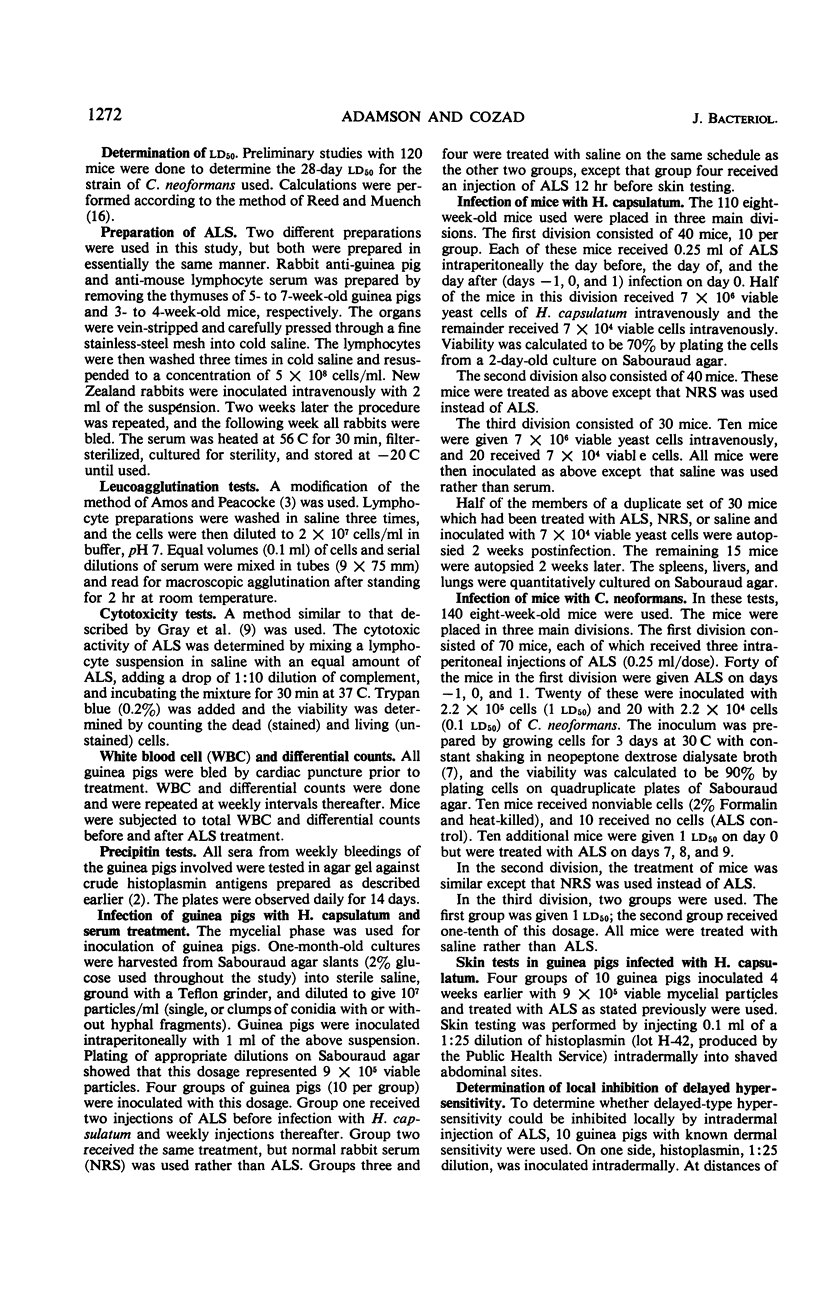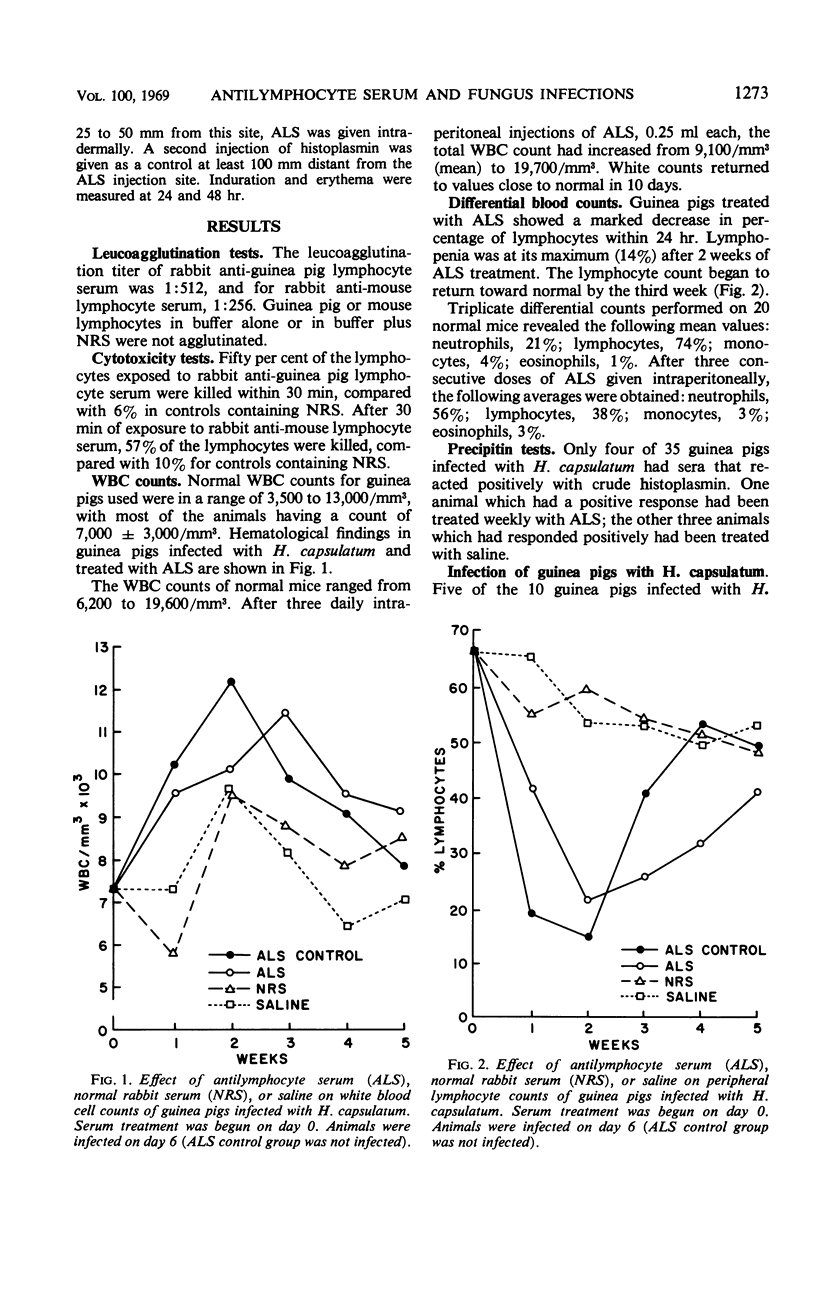Abstract
The anti-mouse and anti-guinea pig antilymphocyte sera (ALS) prepared for this study were shown to contain cytoxic and leucoagglutinating antibodies, and were capable of producing severe lymphopenia in these animals. Guinea pigs treated weekly with ALS were more susceptible to development of fatal infection when inoculated with Histoplasma capsulatum. No fatalities occurred in guinea pigs infected with equal doses of H. capsulatum but treated with normal rabbit serum (NRS) or saline. The time necessary to reach 50% fatality in mice infected with Cryptococcus neoformans was greatly reduced by pretreatment with ALS in comparison with infected controls treated with NRS or saline. When low dosages were used (0.1 ld50), the effect was even more pronounced. Spleen homogenates from mice infected with equal dosages of H. capsulatum and treated with ALS or NRS were cultured. More than 150 times as many organisms were present in the spleens of the ALS-treated group. Similar results were obtained from culturing the lungs and liver. Delayed hypersensitive skin reactions were radically decreased or abrogated in H. capsulatum-infected guinea pigs inoculated intraperitoneally with ALS 12 hr before skin testing with histoplasmin. When ALS was given weekly, the influence on skin reactivity was less notable. Given intradermally, ALS was shown to inhibit the delayed reaction to histoplasmin within a radius of 40 mm.
Full text
PDF





Selected References
These references are in PubMed. This may not be the complete list of references from this article.
- Abaza H. M., Nolan B., Watt J. G., Woodruff M. F. Effect of antilymphocytic serum on the survival of renal homotransplants in dogs. Transplantation. 1966 Sep;4(5):618–632. doi: 10.1097/00007890-196609000-00008. [DOI] [PubMed] [Google Scholar]
- Adamson D. M., Cozad G. C. Immunoelectrophoretic studies of sera from rabbits exprimentally infected with Histoplasma capsulatum. J Bacteriol. 1966 Oct;92(4):887–891. doi: 10.1128/jb.92.4.887-891.1966. [DOI] [PMC free article] [PubMed] [Google Scholar]
- Barth R. F., Southworth J. Studies on heterologous antilymphocyte and antithymocyte sera. II. Effects on cellular antibody production during the early primary and secondary immune response of mice to sheep erythrocytes. J Immunol. 1968 Dec;101(6):1283–1290. [PubMed] [Google Scholar]
- Denman A. M., Frenkel E. P. Mode of action of anti-lymphocyte globulin. I. The distribution of rabbit anti-lymphocyte globulin injected into rats and mice. Immunology. 1968 Jan;14(1):107–113. [PMC free article] [PubMed] [Google Scholar]
- EVANS E. E., KESSEL J. F. The antigenic composition of Cryptococcus neoformans. II. Serologic studies with the capsular polysaccharide. J Immunol. 1951 Aug;67(2):109–114. [PubMed] [Google Scholar]
- FELDMAN J. D., NAJARIAN J. S. DYNAMICS AND QUANTITATIVE ANALYSIS OF PASSIVELY TRANSFERRED TUBERCULIN HYPERSENSITIVITY. J Immunol. 1963 Sep;91:306–312. [PubMed] [Google Scholar]
- Gray J. G., Monaco A. P., Wood M. L., Russell P. S. Studies on heterologous anti-lymphocyte serum in mice. I. In vitro and in vivo properties. J Immunol. 1966 Feb;96(2):217–228. [PubMed] [Google Scholar]
- Hook W. A., Chirigos M. A., Chan S. P. Increased tumorigenesis of murine sarcoma virus (Moloney) by coinfection with Rauscher virus or by treatment with antilymphocyte serum. Cancer Res. 1969 May;29(5):1008–1012. [PubMed] [Google Scholar]
- Levey R. H., Medawar P. B. Further experiments on the action of antilymphocytic antiserum. Proc Natl Acad Sci U S A. 1967 Aug;58(2):470–477. doi: 10.1073/pnas.58.2.470. [DOI] [PMC free article] [PubMed] [Google Scholar]
- Levey R. H., Medawar P. B. Nature and mode of action of antilymphocytic antiserum. Proc Natl Acad Sci U S A. 1966 Oct;56(4):1130–1137. doi: 10.1073/pnas.56.4.1130. [DOI] [PMC free article] [PubMed] [Google Scholar]
- MCCLUSKEY R. T., BENACERRAF B., MCCLUSKEY J. W. STUDIES ON THE SPECIFICITY OF THE CELLULAR INFILTRATE IN DELAYED HYPERSENSITIVITY REACTIONS. J Immunol. 1963 Mar;90:466–477. [PubMed] [Google Scholar]
- Monaco A. P., Wood M. L., Gray J. G., Russell P. S. Studies on heterologous anti-lymphocyte serum in mice. II. Effect on the immune response. J Immunol. 1966 Feb;96(2):229–238. [PubMed] [Google Scholar]
- Russell P. S., Monaco A. P. Heterologous antilymphocyte sera and some of their effects. Transplantation. 1967 Jul;5(4 Suppl):1086–1099. doi: 10.1097/00007890-196707001-00044. [DOI] [PubMed] [Google Scholar]
- Volkert M., Lundstedt C. The provocation of latent lymphocytic choriomeningitis virus infections in mice by treatment with antilymphocytic serum. J Exp Med. 1968 Feb 1;127(2):327–339. doi: 10.1084/jem.127.2.327. [DOI] [PMC free article] [PubMed] [Google Scholar]
- WAKSMAN B. H., ARBOUYS S., ARNASON B. G. The use of specific "lymphocyte" antisera to inhibit hypersensitive reactions of the "delayed" type. J Exp Med. 1961 Dec 1;114:997–1022. doi: 10.1084/jem.114.6.997. [DOI] [PMC free article] [PubMed] [Google Scholar]


